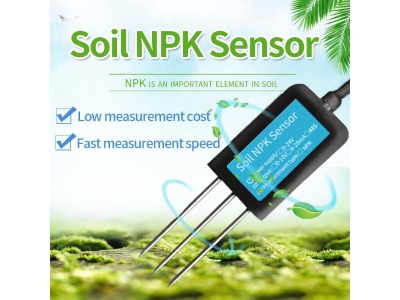Smart farming, also known as precision agriculture, has emerged as a game-changer in the agricultural industry. By leveraging advanced technologies, smart farming aims to maximize productivity, optimize resource utilization, and promote sustainable practices. One of the key technologies revolutionizing smart farming is soil sensors. These sensors provide real-time data on soil conditions, enabling farmers to make informed decisions and improve crop yields. This article explores how soil sensors are unlocking the potential of smart farming and transforming the future of agriculture.

The Role of Soil Sensors in Smart Farming:
Soil sensors are devices that measure various parameters in the soil, such as moisture levels, temperature, nutrient content, and pH levels. They can be embedded in the ground or installed above the soil surface. The sensors collect data continuously and transmit it to a central system for analysis. This real-time information empowers farmers to understand their fields better and make data-driven decisions to optimize farming practices.
Precise Resource Management:
One of the significant advantages of soil sensors in smart farming is their ability to optimize resource management. By accurately measuring soil moisture levels, sensors help farmers optimize irrigation practices. Over-irrigation can lead to water wastage and leaching of nutrients, while under-irrigation can result in decreased crop yields. With soil sensors, farmers can determine the exact water requirements of their crops, ensuring precise irrigation scheduling and efficient water usage. This not only conserves water but also reduces energy consumption associated with pumping and delivering water to the fields.
Nutrient Monitoring and Fertilizer Application:
Proper nutrient management is crucial for crop growth and development. Soil sensors play a vital role in monitoring nutrient levels in the soil. By analyzing nutrient data collected by sensors, farmers can identify deficiencies or excesses and apply fertilizers accordingly. This targeted approach reduces the overall use of fertilizers, minimizes environmental pollution, and improves crop health. Additionally, soil sensors enable farmers to optimize the timing and dosage of fertilizer application, ensuring that crops receive the right nutrients at the right time.
Soil Health Monitoring and Preservation:
Soil degradation is a significant challenge faced by modern agriculture. Factors such as erosion, compaction, salinization, and chemical pollution can degrade soil quality and impact crop production. Soil sensors help monitor soil health parameters, alerting farmers to potential issues. By detecting signs of erosion or compaction, farmers can take preventive measures to mitigate soil degradation. Furthermore, sensors can identify excessive salt levels or harmful chemical concentrations in the soil, allowing for timely intervention. By preserving soil health, farmers can ensure sustainable production and maintain the long-term viability of their land.
Precision Farming and Decision Support:
The integration of soil sensors with other technologies, such as geographic information systems (GIS) and remote sensing, enables precision farming and enhances decision-making processes. Soil sensor data, combined with satellite imagery and weather forecasts, provides farmers with detailed information about their fields. This data helps optimize planting patterns, adjust irrigation and fertilization schedules, and identify areas prone to pest infestations or diseases. Precision farming minimizes input wastage, maximizes crop yields, reduces environmental impact, and increases overall farm profitability.
Challenges and Future Directions:
While soil sensors offer immense potential in smart farming, there are challenges that need to be addressed. Cost, technical limitations, and data management complexities are some of the barriers to wider adoption. However, ongoing research and developments in sensor technology are overcoming these obstacles. Future directions may include the miniaturization of sensors, improved wireless communication, advanced data analytics, and integration with autonomous farming systems. These advancements will make soil sensor technology more accessible and user-friendly for farmers of all scales.

Conclusion:
Soil sensors are unlocking the potential of smart farming by providing real-time data on soil conditions, enabling precise resource management, promoting sustainable practices, and enhancing decision-making processes. By harnessing the power of soil sensors, farmers can optimize irrigation, monitor nutrient levels, preserve soil health, and adopt precision farming techniques. As technology continues to advance, the integration of soil sensors with other cutting-edge innovations will further revolutionize smart farming and shape the future of agriculture. The limitless possibilities offered by soil sensor technology hold the key to a more productive, eff
